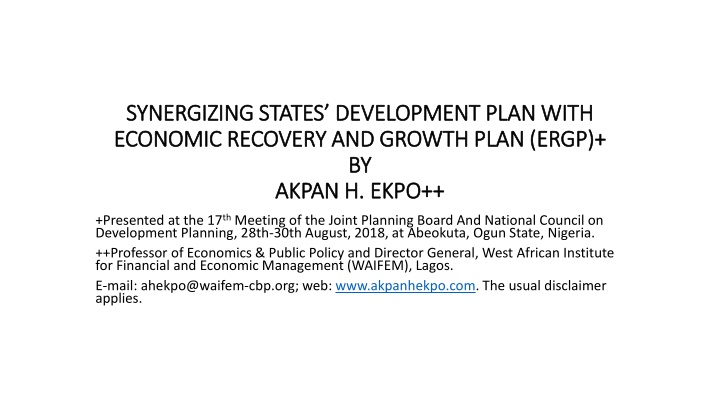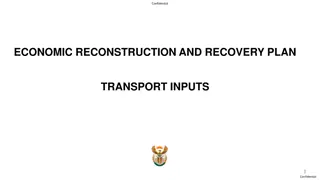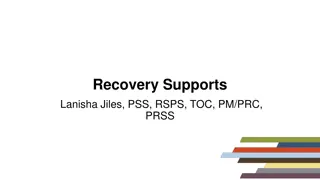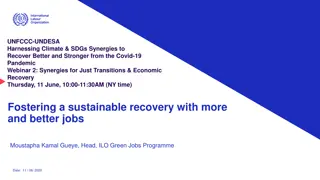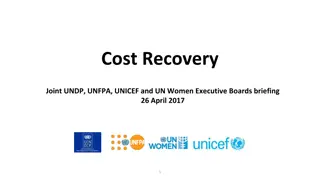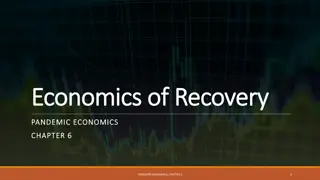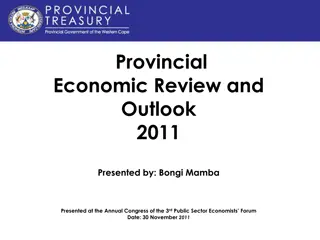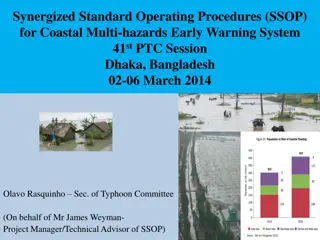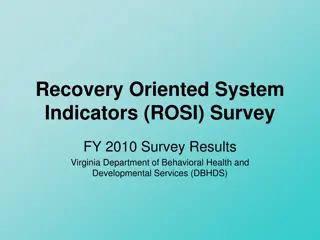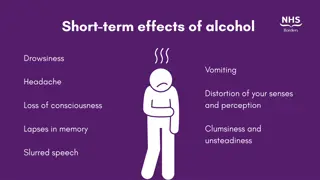Synergizing States Development Plan with Economic Recovery and Growth Plan
This presentation by Professor Akpan H. Ekpo focuses on aligning states' development plans with the Economic Recovery and Growth Plan (ERGP) in Nigeria. It outlines the rationale for policy coordination, frameworks for synergy, and strategies to address challenges, aiming to boost economic recovery and sustainable growth.
Download Presentation

Please find below an Image/Link to download the presentation.
The content on the website is provided AS IS for your information and personal use only. It may not be sold, licensed, or shared on other websites without obtaining consent from the author.If you encounter any issues during the download, it is possible that the publisher has removed the file from their server.
You are allowed to download the files provided on this website for personal or commercial use, subject to the condition that they are used lawfully. All files are the property of their respective owners.
The content on the website is provided AS IS for your information and personal use only. It may not be sold, licensed, or shared on other websites without obtaining consent from the author.
E N D
Presentation Transcript
SYNERGIZING STATES DEVELOPMENT PLAN WITH SYNERGIZING STATES DEVELOPMENT PLAN WITH ECONOMIC RECOVERY AND GROWTH PLAN (ERGP)+ ECONOMIC RECOVERY AND GROWTH PLAN (ERGP)+ BY BY AKPAN H. EKPO++ AKPAN H. EKPO++ +Presented at the 17thMeeting of the Joint Planning Board And National Council on Development Planning, 28th-30th August, 2018, at Abeokuta, Ogun State, Nigeria. ++Professor of Economics & Public Policy and Director General, West African Institute for Financial and Economic Management (WAIFEM), Lagos. E-mail: ahekpo@waifem-cbp.org; web: www.akpanhekpo.com. The usual disclaimer applies.
Outline Introduction Brief on the economy Why Planning? Causes of the Recession Brief on ERGP Rational for Policy Coordination Framework for Synergizing SDP with ERGP Strengthening Policy Coordination Addressing Challenges Using States Plans and ERGP Conclusion JOINT PLANNING BOARD MEETING ABEOKUTA AUGUST 2018 2
Introduction The Nigerian economy and planning Signs of an impending economic recession were visible from 2011/12 rising unemployment, declining productivity and double digit inflation Economy was in a stagflation phase since 2011 By 2016 the economy had entered a recession as evidenced by two consecutive quarters negative growth of GDP Economic Recovery and Growth Plan was put together by the new government to ensure economic recovery and put the economy on the path of sustained growth By 2020, the economy would grow by 7 per cent JOINT PLANNING BOARD MEETING ABEOKUTA AUGUST 2018 3
Growth Vs Development and the ERGP Nigeria has 774 local governments, 36 States, One FCT but one economy. Hence, the importance of states in growing the economy According to the 1999 constitution, states have the right to spend and about 48 per cent of revenue go to States; States are vibrant components of the wider economy; every day economic activities are taking place in all the states JOINT PLANNING BOARD MEETING ABEOKUTA AUGUST 2018 4
Brief on The Nigerian Economy JOINT PLANNING BOARD MEETING ABEOKUTA AUGUST 2018 5
Table 2: Nigeria. Annual Real Growth and Contribution by sectors, Year-on Year (%) JOINT PLANNING BOARD MEETING ABEOKUTA AUGUST 2018 6
WHY PLANNING? Market failure: -Monopoly and Oligopoly power -External economies where environmental factors exert influence -External diseconomies -Markets, which may not accommodate the changes needed for the economic structure to develop, e.g. infant industry argument -Underdeveloped institutions -Macroeconomic imbalances -National goals, which may undermine the objectives of the market JOINT PLANNING BOARD MEETING ABEOKUTA AUGUST 2018 9
Beyond market failure Government failure Need to guide economic development What is crucial is the rational direction of the economy as opposed to efficient allocation of resources In a typical market economy, outcomes can be irrational in at least two ways: (a) market prices depend on the distribution of income from wealth which has no rational basis; and (b) the market does not allow for distribution according to need; instead, a rational plan would determine rationally what needs are to be met and which would be left to individual decisions through markets (Ekpo, 2011). JOINT PLANNING BOARD MEETING ABEOKUTA AUGUST 2018 10
Causes of the Recession Sharp decline in oil prices with adverse implications for the economy Under investment Under consumption (inadequate aggregate demand) Salaries, wages and allowances owed to workers in almost all states for a long period of time Structural challenges Recession was of a special type demand and supply Remedies: Fiscal and structural JOINT PLANNING BOARD MEETING ABEOKUTA AUGUST 2018 11
Sustained deficits at the sub-national government level results in distortions in the wider economy: macroeconomic management of the economy becomes a challenge ERGP, a medium-Term Plan 2017-2020 builds on the Strategic Implementation Plan (SIP) which was anchored on the 2016 budget of change JOINT PLANNING BOARD MEETING ABEOKUTA AUGUST 2018 12
BRIEF ON ERGP Principles of ERGP: -Focus on tackling constraints to growth -Leverage the power of the private sector -Promote national cohesion and social inclusion -Allows market to function (where necessary) -Uphold core values Broad objectives of the plan: -Restoring growth -Investing in the people -Building a globally competitive economy JOINT PLANNING BOARD MEETING ABEOKUTA AUGUST 2018 13
For the ERGP to succeed, states must key in The economy has exited the recession but still in stagflation hence the growth component is crucial and states must buy in to enhance the growth path ERGP should have been launched together with that of States since they were part of the process; however, it is better late than never States must produce their own recovery and growth plans which should be aligned to the ERGP Fiscal sustainability plan must be part of the States ERGP There must be policy co-ordination among MDAs within states JOINT PLANNING BOARD MEETING ABEOKUTA AUGUST 2018 14
Rational for Policy Coordination The rational for policy coordination derives from the fact that policy formulation, analysis and implementation should aim at achieving improved performance and better public service delivery. Policy making is essentially about changing the way the business of development is carried out in government. The change needs to be coordinated, duplication avoided, interdependencies, among them to be recognized, sequencing to be done systematically and synergy among then to be maximized so as to achieve maximum outcomes for a given amount of resources. JOINT PLANNING BOARD MEETING ABEOKUTA AUGUST 2018 15
Defining a reference point against which coordination of all reforms can be measured. Coordination between policies in various ministries and sectors need to be referenced to a clear national development framework. Budgeting processes Coordination between components of policy processes within Ministries and/or within sectors to streamline all activities of those MDAs. Operational level where such policy coordination issues are addressed like the cabinet, inter-ministerial, Technical committees, etc. Structural lags delays and timing JOINT PLANNING BOARD MEETING ABEOKUTA AUGUST 2018 16
The Recognition lag which is the time difference between the occurrence of the problem and its manifestation in the statistical trends. To address this problem, the quality of data management ought to improve. The Administrative lag this is the waiting period between the recognition of the problem and taking definite action on the matter. This challenge is due to the slow process of decision-making by the National Assembly; politics dominates the decision-making process. The Operation lag which connotes the time required for the implementation of economic policy to have the desired effects. This is often caused by bureaucratic bottlenecks, lack of inter-ministerial coordination, dependence on foreign sources of supplies and consultants as well as poor infrastructure. This is unhealthy for stabilization purposes. JOINT PLANNING BOARD MEETING ABEOKUTA AUGUST 2018 17
Strengthening Policy Coordination Capacity building and Training Up-scaling the incentive structure in the civil service Commitment and dedication Quality of leadership at all levels Avoiding and/or minimizing policy reversals Inter and intra ministerial coordination Quality of government intervention Evidence-based policy research for managing the state economy Nature of Nigeria s fiscal federalism: need for competitive federalism JOINT PLANNING BOARD MEETING ABEOKUTA AUGUST 2018 18
Framework for Synergizing SDP with ERGP In developing a framework for synergizing SDP and ERGP, some assumptions need to be put in place. State governments must endorse the thrust of the ERGP and be committed to it States need to agree on some minimum set of priorities that each government must reflect in its SDG; such as agriculture, SMEs, maintenance of infrastructure (roads), public finance management and transparency Technical assistance with aid of development partners to strengthen SDP States need to set up SDP implementation teams. JOINT PLANNING BOARD MEETING ABEOKUTA AUGUST 2018 19
Framework for Synergizing SDP with ERGP The framework based on the standard strategic planning cycle used by many governments around the world set s out the implementation process in 5 steps: 1) Setting Targets, 2) Developing Strategies, 3) Planning and Allocating Resources, 4) Implementation and 5) Monitoring and Evaluation. 1. Setting Targets: Stakeholders at the State level will have a (long- term) policy target. SDP should set milestones (interim targets) on how the long term policy target would be met. Recommend technique of SMART targets: ensure every milestone is Specific, Measurable, Achievable, Realistic, and Time Bound. Every target is achievable if it s realistic and a strategy to meet it 2. Deciding Strategy: Work out how each target will be achieved. Given that various possible strategies exist, the SDP team should be able to analyze which strategy will be most economic and effective. JOINT PLANNING BOARD MEETING ABEOKUTA AUGUST 2018 20
Framework for Synergizing SDP with ERGP 3. Each state must demonstrate a reasoned and fully costed strategy to deliver its policy targets. Detailed process to estimate the financial, human and other resources needed to deliver a given level of public services be detailed. Activity-Based Budget techniques are recommended to ensure all cost implication are taken into account, recurrent and capital expenditure, how to fit this into the requirements of Financial Regulations. Analyze Revenue side of the budget, including IGR, Debt Management, and management of Statutory Allocation 4. SDP implementation: Coordination is a major challenge and implementation team with well defined roles and functions are required to ensure good understanding and cooperation JOINT PLANNING BOARD MEETING ABEOKUTA AUGUST 2018 21
Framework for Synergizing SDP with ERGP 5. Monitoring and Implementation: M&E is to make government more effective by measuring its performance against the targets it has set. It gives the people information it needs to hold govt to account on its promises; M&E enables govt to find out what is working and what is not working and the reasons why. This enables govt to adjusts its targets, improve on strategies, and revised allocation JOINT PLANNING BOARD MEETING ABEOKUTA AUGUST 2018 22
STATES DEVELOPMENT PLANS AND ERGP WOULD ADDRESS THESE CHALLENGES Growth Related: Reversing the trend of growth without employment (jobless growth paradox) Achieving significant reduction in the incidence of poverty (now about 70 percent) Reduce the pervasive high inequality in income Improving the efficiency of small-medium-scale enterprises Reversing the trend of growth in the manufacturing sector with low capacity utilization and low value-added JOINT PLANNING BOARD MEETING ABEOKUTA AUGUST 2018 23
Diversifying the economy as a mitigating factor to the vagaries of the global oil market Improving the quality of output and competitiveness through massive expenditure on physical infrastructure such as power Enhancing the production base through knowledge application and local content policy Reversing the dualism and informality of the economy Reducing the high expenditure dependence of food imports (> 40 percent) in the wake of lack lustre growth of agriculture Low financial intermediation high lending rates thus killing the real sector Social stability JOINT PLANNING BOARD MEETING ABEOKUTA AUGUST 2018 24
Relating to the Implementation of Fiscal Policy Reduced capital budget implementation Rising recurrent expenditure (averaging 70 per cent) exceeding capital expenditure yet the latter is crucial for growth Budget monitoring and evaluation which is very limited, selective as well as irregular Evidence of fiscal dominance with its implications on the conduct of monetary policy Dominance of oil revenue in the realized total revenue JOINT PLANNING BOARD MEETING ABEOKUTA AUGUST 2018 25
Intergovernmental fiscal coordination, which is ineffective. It is not clear whether the centre considers the revenue profiles of sub- national governments when considering its budget constraint Good Governance -Weak institutions and regulatory deficit -Policy reversals and lack of follow through -Combating corruption Macroeconomic stability and unemployment JOINT PLANNING BOARD MEETING ABEOKUTA AUGUST 2018 26
Conclusion States must have their own ERGP which must be in sync with that of the government at the center The success of the ERGP relies on the buy-in of states Growth must be double-digit sustained for at least 10 years to have a dent on poverty reduction ERGP is a good beginning Ministry of Budget and National Planning must assist states to develop their own ERGP without delay. JOINT PLANNING BOARD MEETING ABEOKUTA AUGUST 2018 27
THANK YOU FOR YOUR ATTENTION ahekpo@waifem-cbp.org JOINT PLANNING BOARD MEETING ABEOKUTA AUGUST 2018 28
